|
CHAPTER EIGHT
TRILATERAL HATRED OF GOLD
Trilaterals hate gold because it is a restriction, and an
insurmountable restriction, on the fulfillment of their global
ambitions. An “elastic” currency controlled by the Federal Reserve
System gives power to control the broad direction of the financial
structure and the economy. Gold, however, gives sovereignty to
individuals and removes them from the center of authority. No
totalitarian system can be operated on gold: both Hitler and Stalin
are proof of this point. Similarly, Trilaterals need to remove gold
from the world monetary system before their globalist ambitions can
be achieved.
Triangle Paper 1, Towards a Renovated World Monetary System,
contains the blueprint for world monetary arrangements. Naturally,
gold, the challenge to the world order authority, is treated with
disdain
in the New World Order central bank; and it is proposed that. Reserves will be held only as
Bancor, an artificial
“goldless” money,
. National currencies will not be counted in reserves, and . Gold
will have no role at all in the new international money system.
The Trilateral Commission has its hands squarely on the U.S. gold
policy faucet: any decision to sell U.S. official gold reserves will
be
made by Commissioner W. Michael Blumenthal (secretary of the
treasury) and Anthony Solomon (under secretary of the treasury for
monetary affairs). However, Triangle Paper 1 also reflects enough
realism to agree that this goldless artificial money world is “some
time
away.”
The authors, therefore, propose certain market actions to
reduce
the international monetary role of gold. “We believe in action
consonant with our long-run objectives and at the same time
advancing
the interim aim of calming markets would be the coordinated and
joint
sale of official gold into private markets.” l
The stated intent in Paper 1 is to depress the price of gold
“greatly”
and “interject much uncertainty into the market place.” An earlier
Trilateral proposal to use gold sales to raise funds for the LDCs
has
already been adopted, and Trilaterals have the political clout in
IMF
and the treasury to carry out such policies in the immediate future.
For
example, a recent letter (dated 19 July 1978) from assistant
secretary
for legislative affairs at the treasury to Congressman J. Kenneth
Robinson even went so far as to reject the national security role of
the
U.S. gold reserves:
The Treasury program of monthly public sales of gold does not affect
the ability of the United States to meet strategic or domestic gold
mines which exceeds that required for defense-related uses.
Moreover, our existing stocks are extremely large in relation to
such uses for the foreseeable future. Gold is not an important
medium of payment, and the relatively small amounts which might be
useful in unusual circumstances can readily be provided. We have
seen no practical need, therefore, to regard any specific portion of
our stocks as a contingency reserve.
Trilateral gold policy reveals a long-run intent to impose a world
dictatorship through control of money but also an uncomfortable
awareness that gold is a fundamental challenge to these objectives.
In contrast to this wariness, the Trilateral gold proposals will not
solve their problem. The war on gold is age old. It didn’t start
with current New World Order dreams. No political power has ever
defeated gold because it is portable sovereignty. Those individuals
who dislike or distrust Trilateral intentions will simply buy and
hold onto gold. Gold is their lifeline to a sane world, and it will
be the Achilles’ heel of the Trilaterals.
What the Trilaterals do not understand is the vital necessity of
gold
for any nation. Maybe the Trilaterals dream of a goldless one-world
dictatorship, but they need gold to attain this dream. History is
replete
with instances of the usefulness of gold. The U.S. financed and won
World Wars I and II with gold. In 1941 we had almost two-thirds of
the
world’s gold stock and a national debt of only $40 billion, short
term
obligations to foreigners of only $3 to 4 billion, a favorable
balance of
payments, and a money supply of only $42 billion covered by $24
billion in gold, a ratio better than 1:2.
In 1943, when it looked as
if Rommel were defeating our forces at Kasserine Pass, General Mark
Clark had to pay for military supplies in gold: suppliers would not
accept paper dollars. The same happened in the Pacific following
defeat
at Pear I Harbor. French monetary expert, Jacques Rueff, de Gaulle’s
financial adviser stated: “I am not sure that your military people,
for
reasons of national security in case of emergency want to be left
with
so little gold.” 2
Proponents of a goldless world speculate that the value of the
dollar its purchasing power abroad -depends on a country’s
productivity without the gold cover.
Under the guidance of academic monetary experts, Trilaterals have
been assured that gold can safely be removed from the world monetary
system. For instance, Charles Kindleberger, professor of economics
at MIT made the following statement to Congress in 1968:
My inclination is to stabilize the ratio of gold to dollars as long
as our gold stocks hold out -and I predict that this will be a very
long time -and then to move, not to gold, but to dollars as an
international medium of exchange, as it now is, and store of value,
as it is in part -dollars managed by an internationally determined
monetary policy, to be sure, but dollars.
An analogy between language and money suggests that the
dollar is the equivalent of English, which is the world’s lingua
franca for communication, especially in business and science;
the French proposal to return to gold is like trying to restore
the world to the use of Latin, the language of world
intellectuals in the Middle Ages. 3
This statement is ridiculous in the face of history. No fiat
currency has ever survived. Yet in spite of history, the Trilateral
commissioners have a concerted action plan to implement a sell-gold
policy.
Commissioner John H. Perkins (chairman of the Continental
Illinois Bank and Trust Company) has discontinued sales of all gold
coins at his bank (Krugerrands, Mexican pesos, and Austrian
coronas),
reportedly because gold coin sales weren’t producing profit for the
bank. More likely, however, the move was in line with overall
Trilateral objectives. Paradoxically, Perkins wrote in Trialogue
(Spring
1976) that “it will be little benefit to anyone if there is a
repetition of
the policies which led to the devastating world wide inflation and
subsequent recession experienced during the first half of the
1970s.” 4
In another action, Commissioner Harold Brown (secretary of defense)
has ordered the Department of Defense (DOD) to dispose of the
emergency store of 15,000 gold sovereigns and gold napoleons used in
the “escape kits” carried by air crew members over hostile
territory. From now on, USAF crew members crash landing in enemy
territory will presumably offer paper dollars or computer blip
Special Drawing Rights (SDRs) to hostile inhabitants.
Commissioner Blumenthal has blocked the effort of the President’s
Commission on Olympic Sports to mint a gold commemorative coin or
medal. The committee estimates a gold coin would generate $300 to
500 million for the Olympics. Unknown to the committee, its gold
program is unwelcome to the Trilaterals -it would put gold in the
hands of individuals.
Moreover, a bill to strike gold medallions from the U.S. gold stock
(SB 2843) introduced by Senator Jesse Helms has come under bitter
attack from Blumenthal and the treasury. Blumenthal has stated
publicly that he fears the medallion will be used as a coin:
I do not believe it is in the public interest for the U.S.
Government to take an action which would encourage our
citizens to use gold as a substitute for U.S. legal tender as a
medium of exchange; moreover, the issuance of such gold
medallions could lead those who favor the return to a gold-based
domestic monetary system to seek to make such
medallions legal tender as the next step in a continuing
process to restore the monetary role of gold. 5
This statement flies in the face of history: people, not
governments, decide ultimately what will be used as a means of
exchange.
But, the Trilateralists are skating on thin ice in attacking gold;
to
attack from strength, they need gold in the vaults. Perhaps
Trilaterals
actually believe that the United States has the world’s largest
above-ground gold stock. Not only Establishment media but well informed
foreign sources assume that the U.S. has $11.5 billion of good
delivery
gold in Fort Knox which, if placed on the market, would collapse the
price. 6
We know Trilaterals want to sell gold and that W. Michael Blumenthal
and Anthony Solomon will make the decision to sell gold. The
question is, Does the U.S. really have the gold to sell?
Although the official gold reserve statistics are recorded as “Gold
stock -$11.719 (billions),” the United States doesn’t have that much
good delivery gold in the vaults. We assume that the “gold” referred
to in official statistics is good delivery bullion, valued at the
“official price” of $42.22 an ounce, as established on 21 September
1973. This is not so. The bulk of U.S. gold reserves consist of
unmarketable gold alloy of .85 fineness and less, not good delivery
bullion of .995 fineness and above in 400 ounce bars.
The official published statistics are grossly misleading. The latest
unpublished U.S. Treasury inventory of “good delivery gold bars,”
the quality called for in world markets, is as follows (as of 1
November 1977, compared to 1973 to indicate changes):
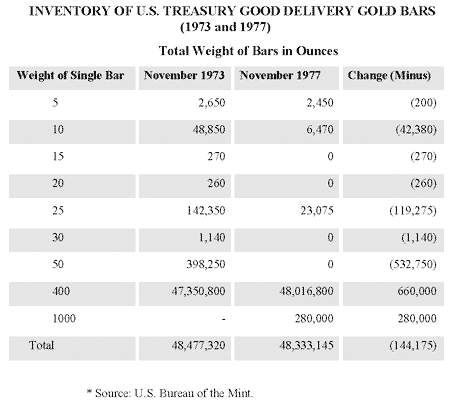
NOTE: At the “official” price of $42.22 per ounce, the U.S. gold
stocks should be recorded as: 48,333, 145 fine ounces times $42.22
equals $2,040,625,381, or roughly $2 billion, compared to the
official published figure of $11.5 billion), assuming this gold is
in the vaults. No physical inventory has been taken. While there
were audits of the seals in 1953 and 1976, audits of seals are not
inventories of gold bars. Readers interested in the possibility of
“missing gold” should send a self addressed business size envelope
(with 24 cents U.S. postage) to Edward Durell, P.O. Box 586-PW,
Berryville, VA 22611 for further information.
The balance of the gold stock is “gold alloy” of .85 fineness or
less,
mostly coin melt (i.e., the coins seized for FDR in 1933). It cannot
be
sold as good delivery.
Compare this 48 million ounces of good delivery gold to the European
stocks:
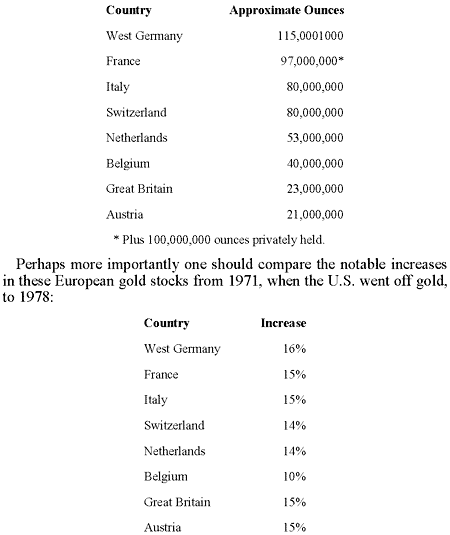
Why not melt the large treasury stock of gold alloy and recast into
good delivery bars?
To a very limited extent, the treasury has done
just
this. Comparison of the U.S. Bureau of the Mint inventory of gold
bars
between November 1973 and November 1977 shows that the mint has
re-melted its stock of “Hershey bars” (i.e., end-of-melt pourings)
of
good delivery fineness into good delivery weights. In the earlier
1973
inventory list, the mint showed numerous bars with weights less than
400 ounces (Le., 5-, 10-, 15-,20-,25-,30-,50-, and 250-ounce bars)
not
acceptable in the international market.
By 1977 many of these bars
had
been re-melted. The 1977 inventory discloses no bars with weights of
15, 20, 30, and 250 ounces, a marked reduction in bars with weights
of 5, 10, 25, and 50 ounces, and an increase of 1,665 bars of 400
ounces good delivery weight. The total inventory of good delivery
gold is a little less -a reduction of 144,175 ounces to 48,333,145
ounces (compared to 48,477,320 ounces in 1973).
A significant change
is 280 additional bars of 1,000 ounce weight.
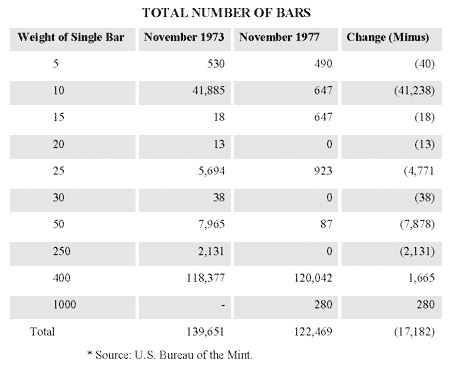
The question remains, what can the mint do with the coin melt bars?
Considering that the U.S. has a total gold refining capacity of
about 2 million ounces per year, it would take seventy-five years to
convert the 150 million or so ounces of coin melt. Although
up-to-date statistics on world gold refining capacity do not exist,
it would surely take many years to refine 150 million ounces of
gold. Moreover, the treasury has protested about the unacceptable
work burden of just counting the bars for a complete physical
inventory. Finally, a re-melt program would raise some awkward
public questions, such as what happened to the original $24 billion
of the U.S. gold stocks?
Of course, the United States could always revalue its good delivery
gold at the market price giving us 48,333,145 ounces times $176.00
(7
February 1978) equals $8,506,633,520. But, this is an impossible
approach for Trilaterals, as it would mean abandoning the “gold is
dead” theme. It is critical for the U.S. Treasury to maintain the
statistical fiction of $11.5 billion of good delivery bullion in
reserve because when the time comes to sell U.S. gold against a
rising gold price, the treasury wants to create the picture of a
vast supply overhang crashing down into the market place. This
supply overhang simply does not exist: $2 billion of good delivery
gold of .995 fineness is far, far less than is needed, even for a
bare minimum strategic reserve.
Now you see why in March 1965 Congress removed the requirement that
Federal Reserve Banks keep a 25 percent reserve in gold certificates
against members’ deposits, and why on 18 March 1968, they removed
the 35 percent reserve requirement against Federal Reserve notes;
and why on 15 August 1973 the U.S. closed the gold window and
suspended convertibility.
And remember this removal of the gold
cover was done over the vehement protest of organizations such as
the Independent Bankers Association of America, which warned:
The lesson of history clearly reminds us that no nation has been
able to survive the deliberate removal of the gold backing from its
currency. The likelihood is that if this universally recognized
basis were eliminated, gold would rapidly flow out of this country.
The Association fears that depriving the United States currency of
its gold backing would do irreparable harm to the nation’s economy
in the years ahead.
On April 5, 1933, Franklin D. Roosevelt, who had entered the White
House only a few days before, issued an executive order requiring
American citizens to surrender gold coins, gold bullion, and gold
certificates to the nearest Federal Reserve Bank. The treasury
offered to pay any cost of transportation, and it is interesting to
note the gold was ordered to the nearest Federal Reserve Bank, a
private organization, not to the nearest United States mint or
depository.
Later in 1933, the Federal Reserve System turned over the
surrendered gold to United States mints. In exchange, the Fed
received Series 1934 gold certificates each with a nominal value of
$100,000, and issued only to the Federal Reserve System by the U.S.
Treasury. Most appropriately, these non-circulating notes bear the
face of Woodrow Wilson, who signed the Federal Reserve Act into law
a few days before Christmas in 1913.
Series 1934 gold certificates are in effect a claim on seized
citizens’ gold by a private money monopoly which we know as the
Federal Reserve System. The certificates bear the following
statement on the obverse:
“This is to certify that there is on deposit in the Treasury of the
United States one hundred thousand dollars in gold payable to bearer
on demand as authorized by law.”
This seizure precedent must be viewed in light of a highly
significant statistic: how much of the circulating gold coin was
surrendered in response to the executive order? Only 49 percent of
gold coins in circulation were actually surrendered, the balance of
the $287 million of gold coins were kept under mattresses and buried
in backyards. This unaccounted-for balance has been written off, or
as Milton Friedman puts it, “the $287 million was retained illegally
in private hands.”
For a year the federal government huffed and puffed and threatened
to sue these Americans who had decided to keep their own coins. Only
one lawsuit was ever filed and that one objection was by an angry
citizen against the federal government to protest seizure of his
gold. The seized gold coins, Double Eagles and Liberty’s,
irreplaceable segments of America’s artistic heritage, were melted
down by the mint to plain gold alloy bars and today form part of the
bulk of our gold reserves.
Gold owners of 1978 area different breed from those of 1933. There
is no likelihood that 49 percent, 15 percent, or even 5 percent of
the citizenry would turn over 1978 gold holdings, and this is
evidenced by the rapidly growing markets for concealment devices,
(safes and vaults).
A Trilateral ban on gold imports is much more likely than another
attempted seizure of citizens’ gold. The excuse for the ban could be
a balance of payments crisis, an energy crisis, or one of several
other created crisis scenarios: the real unstated reason will be
elitist fear of a mass dumping of nonconvertible paper dollars into
gold. Thus the timing of any future gold ban is much more likely to
be determined by a monetary crisis than by an energy or balance of
payments crisis.
A gold import ban would of course generate a temporary premium on
gold bullion and coins, as was the case in France and England.
However, if we follow historical precedent, the premium will decline
as
new gold supplies are smuggled across the Mexican and Canadian
borders and lengthy shorelines, all relatively unguarded.
A ban on gold imports will be required at some point to fulfill
Trilateral monetary objectives, and the risk of public alienation
will be weighed against the long-run objectives. Historically
speaking, the Trilaterals will find that gold bans serve only to
create more anti-Establishment groups.
ENDNOTES: CHAPTER EIGHT
1. “Towards a Renovated World Monetary system,” Triangle Paper No.1,
p.30.
2. Jacques Rueff, The Monetary Sin of the West (New York: Macmillan
Co., 1972), p.
72.
3. “Removal of Gold Cover,” (Statement to Congress, 1978), p. 171.
4. “Looking Forward,” Trialogue (Spring 1976), p. 3.
5. See for example, The Economist. (London), 4 -10 February 1978, p.
113/4. 6. Today these certificates are recorded on the Federal
Reserve “Statement of Condition” as assets. (See, for example, FRS
H. 4) (a) 19 January 1978, p. 2. Gold Certificate Account $11.719
million dollars.
Back to Contents
CHAPTER NINE
TRILATERAL PAPER MONEY SCHEMES
Trilaterals by their own words are interested in political power:
all objectives are subordinate to the political power needed to
order the world as the Trilateralists see fit. So you will not find
rational consideration of alternatives, or the weighing of options
in Trilateral dogma. You can, however, expect an irrational drive,
come what may, to control the world in the name of globalism and New
World Order.
Therefore, you must hold a key fundamental proposition in mind:
Trilaterals are not interested in what monetary system works best,
or most equitably, or whether gold is a more effective monetary
device than paper, or what monetary system will support a higher
standard of living for the world’s poor. The overriding drive for
Trilaterals is to manage the world economy, manage being a euphemism
for control.
This control is exercised through so called
coordination of macroeconomic policy, in spite of the dismal results
from attempted macroeconomic direction. It is argued that the prime
desideratum for this control device is to keep world peace. Nowhere
is there any recognition of the historical fact that such control
has always led to conflict: that denying national and ethnic
independence is a sure road to strife and bloodshed.
Triangle Paper 14, Towards a Renovated International System,
concludes that the 1944 Bretton Woods system has already “come under
increasing strain,” and events have forced traumatic changes, that
is, the periodic assault on the dollar and floating exchange rates.
The current Trilateral objective is to build an international
system, a world order based on cooperation and focusing on two
aspects which require such cooperation:
. International lending
. The creation of international reserves.
he Trilateral proposal is to involve five to ten leading core
countries in establishing the new system. The rest of the world will
have to go along as best it can. Some ideas to this end have already
been implemented: for example, a new, man-made artificial
international money, the Special Drawing Rights (SDRS) has been
created for central banks. As the SDR is introduced, gold will
(supposedly) be phased out of the international reserve system.
The task ahead for the Trilateral Commission world managers is to
integrate these ideas into the world monetary system and make them
work. The immediate and most compelling task is to operate the
floating rate system to dampen erratic movements in exchange rates,
which are, of course, damaging to international trade.
Such erratic
movements do not occur in fixed rates tied to gold. However, gold
moves the world away from the “cooperative” international
arrangements needed by Trilaterals, and gold, therefore, is a bigger
problem than floating rate disorder. Following this is the task of
world
reserve management. The Trilaterals want “wider cooperation since
the
key to world reserve management is restraint in the additions to
central
bank holdings of gold and of course currencies such as the U.S.
Dollar,
the German Mark, the British Pound and the French Franc.” 1
The sinking dollar is also a problem, and an unforeseen one,
particularly as it inevitably leads to lesser use of dollars as a
world reserve unit. Trilaterals with their vague views on gold were
not able to foresee that the 1971 suspension of gold convertibility
would be a millstone around the neck of the dollar and
“international cooperation.”
The following diagram illustrates far
better than words the decline in value of the fiat dollar in
relation to both gold and currencies tied to gold and thus the
decline in the ability of Trilaterals to create a workable fiat
reserve dollar world system.
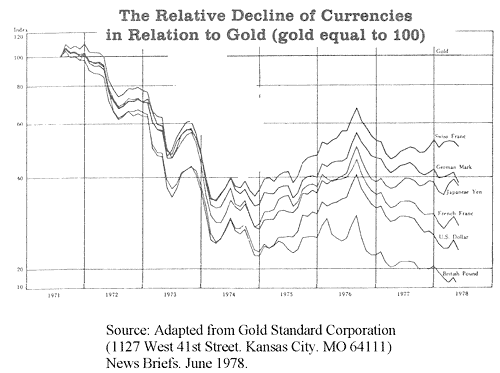
The out-of-date views on gold held by the U.S. Treasury, under
Trilateral control, are well exemplified by a recent letter from
Gene E.
Godley, assistant secretary for legislative affairs at the treasury
to
Congressman J. Kenneth Robinson -a letter which incidentally
illustrates clearly why the treasury has been able to lose billions
of dollars for the U.S. taxpayer.
There is, moreover, a high degree of uncertainty about the
usefulness of gold as money. Its monetary role has greatly
diminished in recent years, and its market price has varied widely.
Thus, our gold stocks no longer represent an assured source of
financing for our imports.
The U.S. Treasury and Trilaterals would do well to ponder the above
chart, and the nonsense it makes of official anti-gold statements.
Using 1971 as a base of 100, all fiat currencies have declined in
value compared to gold, and the U.S. dollar has declined the most
(except for the pound sterling). The Swiss franc and other
currencies tied to gold have declined least. The treasury, under
Trilateralist direction, has assumed facts directly contrary to the
chart.
Trilaterals do recognize that as long as countries build reserves
with national currencies and gold, then the SDR and global fiat
systems will take second place. The IMF is the vehicle to achieve
the twin objectives, and the IMF is supposed to evolve into a
“central bank for national central banks.” At the moment, the IMF
does not have the reserve resources for this: the Trilaterals
propose to artificially create the necessary reserves out of thin
air. The IMF is also supposedly the forum for “coordination of
macroeconomic policies.”
How are our Trilateral friends faring with their plans? To answer
this, we have to go back to Bretton Woods and the Keynes-White
schemes for Bancor and Unitas.
After we identify the differences in
these schemes and why Bretton Woods failed, we can assess the road
ahead for the Trilaterals.
JOHN MAYNARD KEYNES AND HARRY DEXTER
WHITE IN 1944
Keynes was not the originator of the 1944 Bancor scheme, nor are the
Trilaterals the originators of the 1978 Bancor scheme, their global
monetary unit. In 1892 a German economist, Julius Wolf, came up with
the idea of an international gold reserve deposited in a neutral
country with international bank notes issued on the basis of this
gold reserve very much the Keynesian concept reflected in Bretton
Woods and the IMF.
The major differences between 1978 Trilateral
plans and the Anglo-American Keynes-White proposals of 1944 are
these:
. Keynes wanted a “consciousness of consent” from the
general public; Keynes argued the arrangements would
not succeed if hatched in secret.
. The system was to be linked to gold.
Trilaterals have no “consciousness of consent,” and they have
abandoned gold: these are critical differences.
The principal objective in 1944 was much narrower than current
proposals: the system was to be one of multilateral clearing, a
universal currency valid for trade transactions throughout the
world. According to Keynes:
It is not necessary in order to attain these ends that we should
dispossess gold from its traditional use. It is enough to supplement
and regulate the total supply of gold and of the new money taken
together. The new money must not be freely convertible into gold,
for that would require that gold reserves should be held against it,
and we should be back where we were, but there is no reason why the
new money should not be purchasable for gold.” 2
When it came to
christening this new money, Keynes said, “What shall we call the new
money? Bancor? Unitas? Both of them in my opinion are bad names, but
we racked our brains without success to find a better.” Even
“Bezant” was proposed, interestingly the name of the last
international coin (a gold coin) that circulated throughout the then
known world for eight hundred years because it was a gold coin and
never debased.
Actually the two proposals, Bancor (British) and Unitas (United
States), had different features. The adopted American plan, Unitas,
deposited part of the U.S. gold reserves with the IMF together with
a specific amount of domestic currency but created no international
currency. By contrast, the Keynesian plan, Bancor, provided an
international currency with overdraft facilities at the clearing
union. In other words, today the Trilaterals have taken us back to
the Keynesian Bancor plan rejected in 1944.
A comparison of the two monetary schemes clarifies their major
differences:
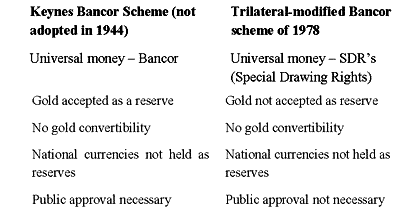
Bancor was not adopted in 1944. It’s now a matter of history that
the related Harry Dexter White Unitas plan which was adopted led the
U.S. into bankruptcy: the dollar weaknesses of today are directly
traceable to the Bretton Woods Unitas plan.
Today’s Trilaterals are political animals, with New World Order
objectives, not interested in orderly world trade but in a specific
future world structure under their control. The question is not to
design a workable system to facilitate trade and improve human
welfare, but to design a system that will enhance and preserve power
for the Trilaterals. The Trilateral answer is to reinvent the system
not used in 1944, the Keynesian Bancor, but modified this time as a
universal currency divorced completely from gold and national
currencies.
The extent of insider willingness to disregard, and even distort,
widely held pro-gold views of others is exemplified by an
extraordinary statement in Robert Solomon’s book, which is aptly
subtitled An Insider’s View.
This is Solomon’s interpretation of the
motivation of gold oriented economists:
Those who are worshipful of gold (gold bugs or, more
politely, chrysophilites) are usually motivated by one or more
of these concerns: particular economic theories now held by a
small minority of economists, distrust of government,
international political objectives (there is discernible among
non-Americans a correlation, far from complete though it is,
between attachment to gold and anti-Americanism), and, last
but not least, hope of personal pecuniary gain. 3
Each of Solomon’s so-called motivations is in error. It may be that
a majority of American economists dislike gold, but certainly not a
majority in the world at large. Anti-goldism is an American
preoccupation. It is not distrust of government per se that
motivates gold holding but distrust of “insiders” who manipulate
government for their own ends. Gold holding is not related to
anti-Americanism, but it may be related to anti-imperialism, a
different aspect altogether.
Neither is gold holding related to pecuniary gain: it is related to
protection of wealth from marauding insiders.
COOPERATION, COORDINATION OR
PIGHEADEDNESS
Trilaterals are failing to achieve the wished-for coordination of
macroeconomic policies among the core countries. In early February
1978 these core country finance ministers, vital to the success of
the revived and modified Bancor, met in Europe -a supposedly secret
meeting that became public knowledge.
There is no concealing the
cold reception for the Trilateral scheme from Europeans. U.S.
Secretary of the Treasury Blumenthal tried to arm-twist Germany into
a “locomotive” role; that is, Germany should reflate, spur its
economy in good Keynesian fashion, and hopefully, pull lagging
economies onto a higher plane of economic activity.
This is
presumably the “coordination of macroeconomic policies” planned. The
Germans welcomed the Keynesian locomotive no more in February 1978
than in previous years. German Economics Minister Count Otto Lambsdorff commented, I am surprised by American stubbornness,” and
Chancellor Helmut Schmidt indicated zero chance of a stimulative
(i.e., inflationary) German policy.
This rather crude Trilateral attempt to strong-arm Europe into
reflation can be compared to the publicly announced method of
achieving cooperation through consultation.
To quote Robert Solomon
again:
Just as there is a need in each country for economic policies
aimed at high employment and price stability, there is a need,
at the international level, for a similar effort to make the
policies of individual countries compatible with the wellbeing
of the world economy. Since there exists no international
authority that can directly perform this function, it can be done
only by means of consultation and cooperation among
representatives of independent nations meeting together in
established international form. 4
This European episode and the later creation of the European
Currency Unit (ECU) exemplifies the Trilateral weakness in
historical precedent. Why did the Germans refuse to go along with
Keynesian demand stimulation? Because two factors are locked into
the German psyche and ignored by American planners. First, the
unparalleled rise of the German economy from the ashes of 1946 was
due to plain old laissez faire free enterprise, not artificial
Keynesian locomotives.
Second, Germany has had two recent devastating price inflations
(1923
and 1946), and both times the Mark went to zero. Germans know the
consequences of inflation and Keynesian-type stimulation.
W. Michael Blumenthal was born in Germany and lived in Shanghai
until 1947. He must have some remembrances of the postwar Chinese
currency inflation and the 1946 collapse of the mark. Unfortunately,
Blumenthal was not in Germany during the years of German economic
revival.
In sum, a combination of factors -German refusal to adopt Keynesian
stimulation, the French political scene, and the collapse in the
leading indicators (signaling a depression in 1979) -has reduced
international cooperation and coordination.
One can perceive in the background a central reason why the
Trilaterals, essentially the big New York banking powers, must move
ahead with Bancor...why they must develop the so-called Witteveen
facility...why they must create elastic international reserves, to
be expanded at the push of a computer key.
The central unstated propellant for global fiat money is that the
international monetary system is on a precarious merry-go-round:
borrow -generate a deficit -be unable to repay -reschedule -borrow
some more. The world debt balloon must be kept inflated. If the
balloon goes bust, so do the New York banks (remember Chase receives
78 percent of its earnings from abroad).
If one of the world players
decides he’s had enough, if a New York bank says no to Zaire, if
Turkey or anyone of a dozen other LDCs default, the whole pack of
monetary cards will come tumbling down. Trilaterals push for an
international monetary system based on Bancor-created money simply
because their banker necks are already in the wringer; the gold
solution is no longer available because the U.S. long ago shipped
out its good delivery gold.
At this stage, Keynesian dogma is useless. Keynes left no guidance
to his followers for the contemporary world mess.
Although he was
personally aware of the role of gold, he did not anticipate that the
greed of his followers might exceed their good sense.
INTERNATIONAL BANKERS AND BANCOR
The benefits of Bancor will accrue to international bankers more
tl1,an to anyone else. The interlock between New York international
bankers, the Trilateral Commission, and thus, Trilateral proposals
in Bancor can be traced precisely.
The earnings that major banks receive from overseas is a matter of
public record and is a measure of the division between their
domestic
interests in the United States and a global economy. The degree of
domestic control over the economy by international banks has been
identified in a report published by the late Senator Lee Metcalf,
“Voting Rights in Major Corporations.”5
Also a matter of public
record are the names of international bankers who are Trilateral
Commissioners. When we integrate these three statistics,
(a) source
of bank earnings
(b) control of domestic companies
(c)
Trilateral membership, we identify a highly significant interlock
between international banks and the Trilateral push for a global
economy
Table 9-1 ranks twelve international banks in order of their 1976
earnings from overseas; that is the bank with the highest percentage
of its earnings from overseas is ranked Number 1, and the bank with
the least percentage from overseas is ranked Number 12 (columns 1
and 2). This percentage is compared with the equivalent 1970 figures
to demonstrate that foreign earnings have ballooned over the past
five years or so (columns 3 and 4).
Column 5 is the Metcalf Index of
domestic control by these same bankers, defined as the number of the
122 companies examined by a congressional committee in which the
bank is among the top five shareholders. Column 6 lists Trilateral
commissioners who are also directors of these banks.
Chase Manhattan is the bank with the highest percentage of earnings
from abroad: a remarkable 78 percent compared to 22 percent in 1970.
In brief, David Rockefeller’s international merchandising has made
Chase a global bank, not an American bank, and we might call David a
de facto world citizen, not an American citizen. At the same time,
Chase has a very low rating on the Metcalf Index. The bank is among
the largest five stockholders in only eight of the 122 companies
studied by the sub committee (compared to Citibank’s 25 and J. P.
Morgan’s 56.)
No fewer than six Chase Manhattan directors (Kissinger is on the
Chase International Advisory Board) are represented on the
Trilateral Commission. In sum, Chase is heavily, almost totally,
oriented outside the United States. Its pecuniary interest in
promoting a New World Order is slightly more than obvious.
Contrast Chase to J.P. Morgan where 53 percent of income is from
overseas (up from 25 percent in 1970) with only one Trilateral
representative. Banks like Charter New York (formerly Irving Trust)
and Chemical Bank do not appear on the Metcalf Index at all and have
no Trilateral representation, that is, they are not apparently
involved in creating a New World Order.
This pattern is dramatized if we rearrange the data in table 9-1
with highest Trilateral representation first.
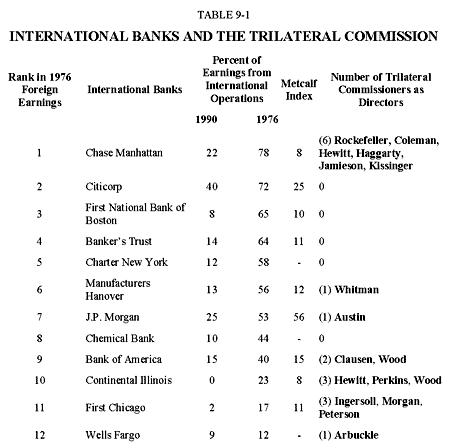
BANKS WITH TRILATERAL REPRESENTATION
In a few words: the Trilateral Commission is dominated by a very few
international banks, essentially Chase Manhattan, and is an
institution focused outside the United States.
At the same time, the
Trilateral Commission has taken over the United States executive
branch. We have not been taken over by communists or Russians or
Martians but by a group which wants to “revise” the Constitution (to
organize more political power) but is without majority financial and
economic ties to the United States.
A REALISTIC VIEW OF THE MONETARY WORLD
A rational international
monetary system now evolving could brush the IMF and the Trilateral
fiat “coordinated” monetary arrangements into the dust. Whatever
foreign finance ministers may say to W. Michael Blumenthal face to
face, a new monetary system is slowly emerging with its roots in
gold, fixed exchange rates, and rejection of Keynesian demand
stimulation techniques.
Pointers to this hard money, gold-based system include:
. Jacques Rueff, de Gaulle’s chief
financial advisor, author of The Monetary Sin of the West,
unabashedly gold oriented, was advising French and Japanese
governments, prior to his death in 1978
. The European attitude to American financial policy is
noticeably hardening: witness
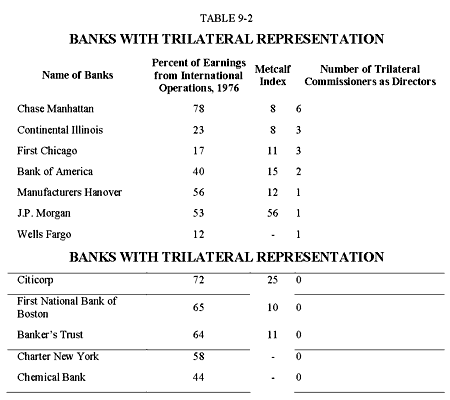
Blumenthal’s February trip to Paris brought hostile European
reaction, and more importantly, the creation of the European
Currency Unit (ECU)
. Japanese citizens may now hold gold deposits outside Japan, and
there are internal efforts to develop the use of gold. Soviets are
interested in a gold-based international monetary system.
. Arabs are skeptical about exchanging scarce crude oil for
ever-depreciating paper dollars and are searching for a reliable
monetary medium.
. South Africa has awakened to U.S. imperial designs in Africa
(“strangling with finesse” as Prime Minister Vorster phrases it).
. At home billions more are scheduled for boondoggles
(Humphrey-Hawkins), which will backfire and push even more Americans
into the hard money camp.
Project the above facts to their logical conclusions and we
conclude:
. Floating rates will be rejected as too costly. Contrast this to
the Trilateral proposal “learning to live with floating rates.”
Fixed rates will return at some point.
. Reintroduction of gold into the world system will pull the
rug from under Trilateral international monetary
arrangements based on Bancor.6
. If the United States, under Trilateral guidance, cannot sell
the core countries on its international monetary
arrangements, it will never sell the other hundred or so
countries in the world.
. Unless the U.S. gets its monetary house in order, it will notably
lose world prestige and influence; it will skirt revolution at home
and endure major social consequences.
ENDNOTES: CHAPTER NINE
1. Motoo Kaji. Richard N. Cooper. Claudia Segre. “Towards a
Renovated World Monetary System,” Trilateral Commission TaskForce
Report No.1 (New York. 1973). p. 19.
2. John Maynard Keynes. Essays in Persuasion (London: Hart-Davis.
1952). p. 209.
3. Robert Soloman. The International Monetary System, 1945-1976: An
Insider’s View (New York: Harper & Row. 1977), p. 333.
4. Ibid.. p. 336.
5. Referred to as the Metcalf Index.
6. This was written in mid-1978, before the gold-based ECU was
announced.
Back to Contents
|






